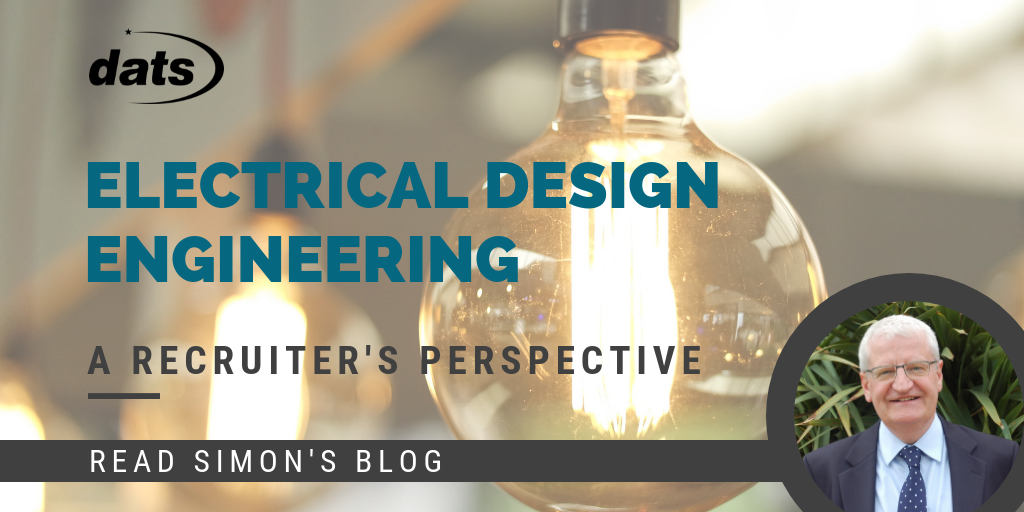

Challenges are common in the engineering industry, but the best talent can jump into those professional gaps left by new pressures and expectations. After 26 years at DATS, Simon Hancock tells us what’s lighting up clients and candidates in Electrical Design engineering…
What’s changed since I first started at DATS? More than I can really summarise here. But there are fewer huge, mainstay employers than there used to be. We’re seeing an influx of contractors and SMEs, each of which work flexibly, moving from project to project and doing an amazing job.
This allows for freedom and diverse experience. But equally, it’s an attractive prospect for anyone building their Electrical Design career. The work is so flexible that candidates and their employers stay motivated, because who knows what’s around the next corner? Good engineers attach themselves to many companies in similar industries, but also those they’re encountering for the first time. Variety keeps the interest up, and that can only be a positive thing!
“The work is so flexible that candidates and their employers stay motivated, because who knows what’s around the next corner?”
However, we can’t deny there’s a skills shortage. Larger chemical companies cover far less ground than they used to, where people could gain an in-work qualification. Now, there’s still demand for the same hands-on experience, but it has to be paired with a fantastic university degree. It’s very, very tough to stand out from the crowd. To do so, a candidate must correlate their academic skills with real-world engineering projects. Meanwhile, the older types of qualifications count for a lot; mature workers have just as much of a chance to land themselves a placement, even if they’ve never been to university.
” It’s very, very tough to stand out from the crowd. To do so, a candidate must correlate their academic skills with real-world engineering projects.”
Earning opportunities are some of the best in the UK
Although some apprenticeships have dried up, a few employers do still run them. Quasi-government initiatives have also been set up to encourage more women to apply. Engineering still has a way to go until the gender imbalance is fully addressed but, slowly, things are changing – women are getting more relevant qualifications at A-level and university, and they’re fighting against a male-dominated culture. Much of the time, they can look forward to amazing rewards.
The starting salary for an Electrical Design Engineer in the Northwest could be as high as £31,000. For anyone in their early 20s, this is a great start. Earnings can rise significantly with experience and chartership. The Electrical Engineering discipline is also still very buoyant discipline with pay rates of £40 per hour for mid-career level engineers with around ten years’ experience. It’s not as much as what the oil and gas boom afforded a little less than a decade ago, but it’s really attractive nonetheless. Nuclear projects are creating the highest skills demand, both for new-builds and decommissioning. So when we look at sites like Sellafield, they need a broad range of electrical abilities. DATS is placing the right people for the job, and we’re happy that the earning progressions are so strong since these roles have massive appeal in the UK economy.
IR35 and government policy will have big ramifications
I couldn’t give an honest breakdown of Electrical Design trends without mentioning IR35… So far, the public sector has changed, it’s now employers – not the contractors – who have to check, verify and maintain that someone is working independently, not on their payroll. Private sector is looking likely to follow the same model.
The switch won’t be set in stone until next April 2020, but some recruiters are already scrambling for an answer. They’ll have to oversee IR35 if the employer doesn’t, and not all of them have the time or knowledge to do so. DATS is different because we run payroll services. Unlike many recruiters, we can adapt and deal with pension requirements and holiday benefits.
I think there’ll be major changes to tax law too. With Corporation Tax, NI, and dividend payments at play – all of the methods a company owner can use to limit their tax bill – the government might clamp down on these incentives, raising more cash for the public purse. If that happens, there will be fewer PSCs (Personal Service Company). Many experienced engineers will be happier to work for employers again, instead of running their own business.
In either case, I’ll keep my ear to the ground! Wherever the industry goes next, we’ll be nurturing talent in the Northwest, and helping them prosper with clients that offer far-reaching development.
If you think Simon could help with your next Electrical Design Engineer role, get in touch with him here.
It’s not too late to get IR35 ready
The changes to IR35 legislation come into effect in just a number of weeks now. Do you feel like you're not yet prepared? Don't worry - there's still time to get ready. And even better, we're here to help!You'll know by now that the responsibility for deciding whether...
2019 Round-up
As we near the end of what’s been a particularly memorable year for DATS, it’s the perfect time to look back on some of our highlights. It’s been a jam-packed 2019, making the months fly by. Here are some of our best bits…New CAD Services Website January was the...
Design for Manufacturing
One of our most recent features explored 3D printing and the benefits it’s bringing to the ever-changing world of manufacturing. It reduces both time and cost in the production and assembly of parts, refining processes and increasing efficiency. But even before we get...




